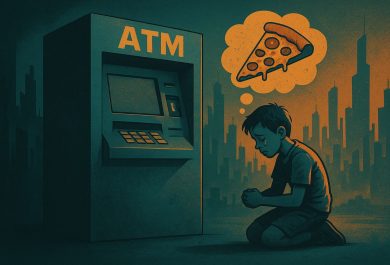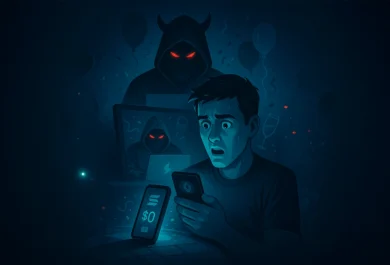From Old‑School Airwaves to New‑School Wealth
His fingers knew the weight of a microphone before they ever touched a blockchain. For years, his world was one of spinning dials, crackling transmitters, and the warm hum of analog radio waves cutting through the static of Lagos nights. As an On-Air Personality for one of Africa’s biggest stations, he lived in a tactile universe where success was measured in decibels and audience calls, not hash rates or smart contracts.
Then 2020 happened.
The pandemic didn’t just silence studios; it exposed how fragile tradition could be. While he adjusted knobs to keep his show’s audio crisp, friends—some of whom couldn’t even explain how a radio signal worked started flaunting Rolls-Royces bought with something called crypto. That was the first time he ever heard of it.
The static between two worlds: A new continent, a new hustle
By 2021, his life had flipped. He, his wife Margaret, and their son packed one suitcase each and moved oceans away to begin a new life. What started as a bold adventure became a survival scramble.
Rent was due, opportunities were thin, and Margaret’s skeptical glances grew heavier. He slid from primetime host to freelance caption writer, shouting edits into the wind while chasing rent deadlines. Still, he clung to one rule from the radio: stories only change when the plot twists.
The whispers of a ghost‑town coin: broadcast from the future
One autumn night, Margaret was scrolling through a Telegram group for scholarship tips when she blurted, “Some folks keep hyping a new coin, but you know me, I’d rather buy shoes than promises.” That throwaway comment smacked him awake.
Jeremiah did what any good journalist would: he researched. Late nights found him squinting at whitepapers instead of scripts, trading soundboards for candlestick charts. The language was foreign—nodes, an obscure proof-of-work token trading peer-to-peer on a scruffy Discord channel, halvings—but the rhythm? That, he understood.
Digging deeper, he discovered no glossy website, no big exchange, just miners swapping fractions of a cent for coffee money. It felt like stumbling onto an unlisted song by a favorite band. So he gambled, not recklessly, but strategically, the way he once chose which songs to play during rush hour.
He had $10,000 stashed for emergencies. A sane father would have guarded that like a family heirloom in China. Instead, he wired USDT to a stranger calling himself “NodeNinja” and received ten million shiny tokens at roughly $0.00050 apiece. His palms still sweat remembering the “pending” screen. Markets moved like audiences: euphoric one day, silent the next. Volatility wasn’t noise; it was feedback. And just like in radio, timing was everything.

The signal boost: From pennies to possibility
For weeks, nothing happened. Price updates were a desert; one sale on Monday and none until Friday. He almost forgot about the wallet… until the coin found its first modest exchange listing that summer. Liquidity trickled in, then came a sudden dam burst: miners shouted about record hashrate, influencers dubbed it “the people’s chain,” and the chart sprinted like a cheetah that smelled dinner.
By December 31, 2022, the token closed at $0.00535. Do the math: his dusty $10k ballooned to roughly $106,800. Ten times over. The number glowed on-screen like a Broadway marquee. The sliver of savings he’d funneled into that coin—half-expecting it to flatline like dead air—screamed to life.
His investment 10×’d; it wasn’t just money, it was validation. The same instincts that told him when to drop a punchline or pivot a debate had steered him right. The upgraded apartment didn’t just have space; it had silence. No more static.
Yet the real lesson wasn’t in the gain. It lay in realizing that blockchain and broadcast weren’t enemies. Both relied on networks, trust, and the courage to transmit into the unknown. The only difference? One required antenna. The other nerve.
Signing off (for now)
They didn’t buy a Lamborghini; they bought breathing room. First, three months’ rent in advance—no more landlord nightmares. Next, second-hand laptops for the kids’ online classes and a little IKEA couch that doesn’t squeak when guests sit. Margaret cried happy tears in the kitchen while he plotted his next risk, humbled and hungry at the same time.
Jeremiah Musa used to ride airwaves, but now he surfs charts.
Remember to DYOR, because even the clearest signals need tuning. And never risk more than you’re willing to lose. After all, whether chasing waves or wallets, every frequency has its fade.
Ever straddled two worlds like this? Drop your story on margaret.jemituwi@rgmedia.io—let’s compare wavelengths.











